浪漫主义时期历史背景及诗人简介
- 格式:doc
- 大小:49.50 KB
- 文档页数:5
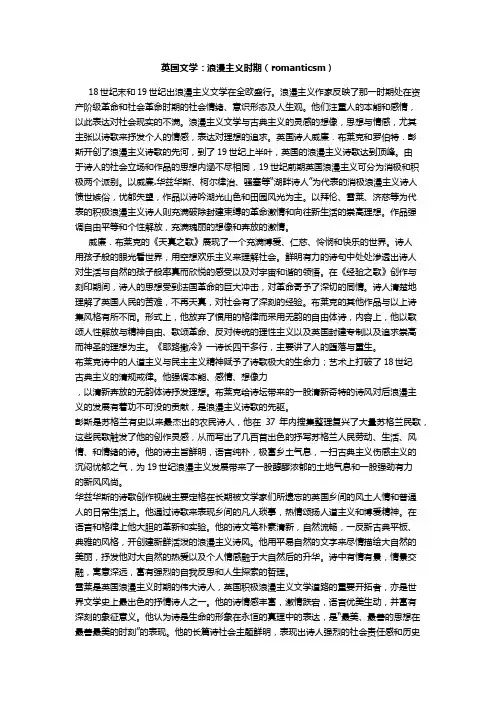
英国文学:浪漫主义时期(romanticsm)18世纪末和19世纪出浪漫主义文学在全欧盛行。
浪漫主义作家反映了那一时期处在资产阶级革命和社会革命时期的社会情绪、意识形态及人生观。
他们注重人的本能和感情,以此表达对社会现实的不满。
浪漫主义文学与古典主义的灵感的想像,思想与情感,尤其主张以诗歌来抒发个人的情感,表达对理想的追求。
英国诗人威廉.布莱克和罗伯特.彭斯开创了浪漫主义诗歌的先河,到了19世纪上半叶,英国的浪漫主义诗歌达到顶峰。
由于诗人的社会立场和作品的思想内涵不尽相同,19世纪前期英国浪漫主义可分为消极和积极两个派别。
以威廉.华兹华斯、柯尔律治、骚塞等“湖畔诗人”为代表的消极浪漫主义诗人愤世嫉俗,忧郁失望,作品以诗吟湖光山色和田园风光为主。
以拜伦、雪莱、济慈等为代表的积极浪漫主义诗人则充满破除封建束缚的革命激情和向往新生活的崇高理想。
作品强调自由平等和个性解放,充满瑰丽的想像和奔放的激情。
威廉.布莱克的《天真之歌》展现了一个充满博爱、仁慈、怜悯和快乐的世界。
诗人用孩子般的眼光看世界,用空想欢乐主义来理解社会。
鲜明有力的诗句中处处渗透出诗人对生活与自然的孩子般率真而欣悦的感受以及对宇宙和谐的领悟。
在《经验之歌》创作与刻印期间,诗人的思想受到法国革命的巨大冲击,对革命寄予了深切的同情。
诗人清楚地理解了英国人民的苦难,不再天真,对社会有了深刻的经验。
布莱克的其他作品与以上诗集风格有所不同。
形式上,他放弃了惯用的格律而采用无韵的自由体诗,内容上,他以歌颂人性解放与精神自由、歌颂革命、反对传统的理性主义以及英国封建专制以及追求崇高而神圣的理想为主。
《耶路撒冷》一诗长四千多行,主要讲了人的堕落与重生。
布莱克诗中的人道主义与民主主义精神赋予了诗歌极大的生命力;艺术上打破了18世纪古典主义的清规戒律。
他强调本能、感情、想像力,以清新奔放的无韵体诗抒发理想。
布莱克给诗坛带来的一股清新奇特的诗风对后浪漫主义的发展有着功不可没的贡献,是浪漫主义诗歌的先驱。

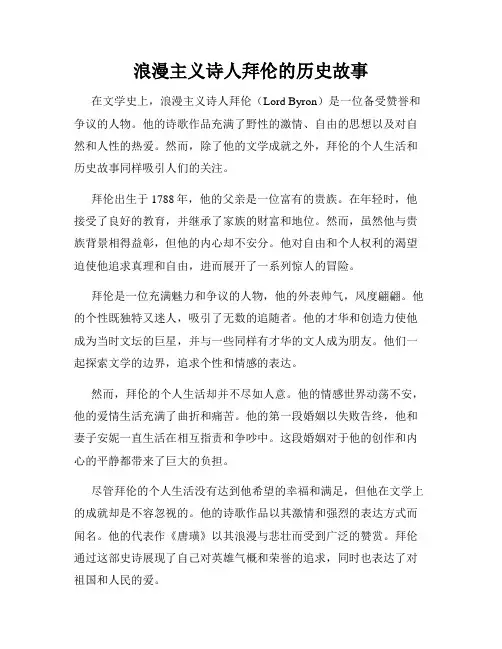
浪漫主义诗人拜伦的历史故事在文学史上,浪漫主义诗人拜伦(Lord Byron)是一位备受赞誉和争议的人物。
他的诗歌作品充满了野性的激情、自由的思想以及对自然和人性的热爱。
然而,除了他的文学成就之外,拜伦的个人生活和历史故事同样吸引人们的关注。
拜伦出生于1788年,他的父亲是一位富有的贵族。
在年轻时,他接受了良好的教育,并继承了家族的财富和地位。
然而,虽然他与贵族背景相得益彰,但他的内心却不安分。
他对自由和个人权利的渴望迫使他追求真理和自由,进而展开了一系列惊人的冒险。
拜伦是一位充满魅力和争议的人物,他的外表帅气,风度翩翩。
他的个性既独特又迷人,吸引了无数的追随者。
他的才华和创造力使他成为当时文坛的巨星,并与一些同样有才华的文人成为朋友。
他们一起探索文学的边界,追求个性和情感的表达。
然而,拜伦的个人生活却并不尽如人意。
他的情感世界动荡不安,他的爱情生活充满了曲折和痛苦。
他的第一段婚姻以失败告终,他和妻子安妮一直生活在相互指责和争吵中。
这段婚姻对于他的创作和内心的平静都带来了巨大的负担。
尽管拜伦的个人生活没有达到他希望的幸福和满足,但他在文学上的成就却是不容忽视的。
他的诗歌作品以其激情和强烈的表达方式而闻名。
他的代表作《唐璜》以其浪漫与悲壮而受到广泛的赞赏。
拜伦通过这部史诗展现了自己对英雄气概和荣誉的追求,同时也表达了对祖国和人民的爱。
除了文学上的成就,拜伦也是一位社会活动家。
他积极参与政治运动,呼吁个人自由和人权的保护。
他关注社会问题,并对希腊独立运动表达了支持。
他的热情和行动激励了许多人,促使他们思考并反抗压迫和不公正。
然而,拜伦的生命却在他年轻的时候中断了。
他于1824年在希腊参加独立运动时感染了恶性疟疾,最终去世。
尽管他的生命短暂而悲剧,但他在短暂的时间里留下了永恒的印记。
浪漫主义诗人拜伦的历史故事展现了一个复杂而多维的人物形象。
他的作品和个人生活都彰显出他对自由、热情和真理的追求。
尽管他的一生充满了挣扎和痛苦,但他的创造力和社会影响力却是不可否认的。
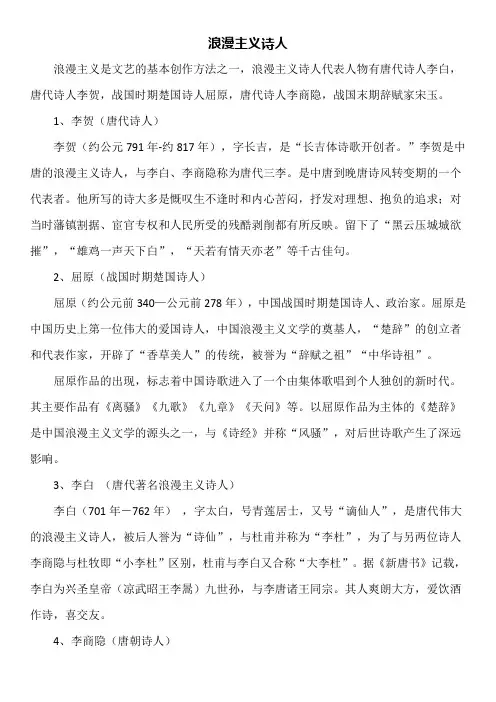
浪漫主义诗人浪漫主义是文艺的基本创作方法之一,浪漫主义诗人代表人物有唐代诗人李白,唐代诗人李贺,战国时期楚国诗人屈原,唐代诗人李商隐,战国末期辞赋家宋玉。
1、李贺(唐代诗人)李贺(约公元791年-约817年),字长吉,是“长吉体诗歌开创者。
”李贺是中唐的浪漫主义诗人,与李白、李商隐称为唐代三李。
是中唐到晚唐诗风转变期的一个代表者。
他所写的诗大多是慨叹生不逢时和内心苦闷,抒发对理想、抱负的追求;对当时藩镇割据、宦官专权和人民所受的残酷剥削都有所反映。
留下了“黑云压城城欲摧”,“雄鸡一声天下白”,“天若有情天亦老”等千古佳句。
2、屈原(战国时期楚国诗人)屈原(约公元前340—公元前278年),中国战国时期楚国诗人、政治家。
屈原是中国历史上第一位伟大的爱国诗人,中国浪漫主义文学的奠基人,“楚辞”的创立者和代表作家,开辟了“香草美人”的传统,被誉为“辞赋之祖”“中华诗祖”。
屈原作品的出现,标志着中国诗歌进入了一个由集体歌唱到个人独创的新时代。
其主要作品有《离骚》《九歌》《九章》《天问》等。
以屈原作品为主体的《楚辞》是中国浪漫主义文学的源头之一,与《诗经》并称“风骚”,对后世诗歌产生了深远影响。
3、李白(唐代著名浪漫主义诗人)李白(701年-762年),字太白,号青莲居士,又号“谪仙人”,是唐代伟大的浪漫主义诗人,被后人誉为“诗仙”,与杜甫并称为“李杜”,为了与另两位诗人李商隐与杜牧即“小李杜”区别,杜甫与李白又合称“大李杜”。
据《新唐书》记载,李白为兴圣皇帝(凉武昭王李暠)九世孙,与李唐诸王同宗。
其人爽朗大方,爱饮酒作诗,喜交友。
4、李商隐(唐朝诗人)李商隐(约813年-约858年),字义山,号玉溪(溪)生,又号樊南生,晚唐著名诗人,和杜牧合称“小李杜”,李商隐又与李贺、李白合称“三李”,与温庭筠合称为“温李”,因诗文与同时期的段成式、温庭筠风格相近,且三人都在家族里排行第十六,故并称为“三十六体”。
李商隐是晚唐乃至整个唐代,为数不多的刻意追求诗美的诗人。

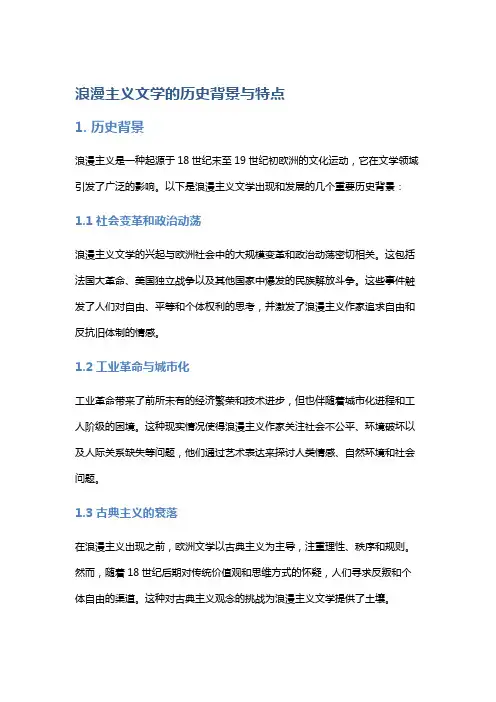
浪漫主义文学的历史背景与特点1. 历史背景浪漫主义是一种起源于18世纪末至19世纪初欧洲的文化运动,它在文学领域引发了广泛的影响。
以下是浪漫主义文学出现和发展的几个重要历史背景:1.1 社会变革和政治动荡浪漫主义文学的兴起与欧洲社会中的大规模变革和政治动荡密切相关。
这包括法国大革命、美国独立战争以及其他国家中爆发的民族解放斗争。
这些事件触发了人们对自由、平等和个体权利的思考,并激发了浪漫主义作家追求自由和反抗旧体制的情感。
1.2 工业革命与城市化工业革命带来了前所未有的经济繁荣和技术进步,但也伴随着城市化进程和工人阶级的困境。
这种现实情况使得浪漫主义作家关注社会不公平、环境破坏以及人际关系缺失等问题,他们通过艺术表达来探讨人类情感、自然环境和社会问题。
1.3 古典主义的衰落在浪漫主义出现之前,欧洲文学以古典主义为主导,注重理性、秩序和规则。
然而,随着18世纪后期对传统价值观和思维方式的怀疑,人们寻求反叛和个体自由的渠道。
这种对古典主义观念的挑战为浪漫主义文学提供了土壤。
2. 特点浪漫主义文学具有以下几个显著特点:2.1 强调个体情感与体验浪漫主义作品强调个体的情感和内心世界。
作家通过展示角色的深情厚意、激情澎湃以及苦闷孤独等复杂情感来吸引读者。
他们追求真实自我的表达,倡导诗意生活和灵魂之旅。
2.2 对自然的崇拜与画面化描写浪漫主义者对自然怀有敬畏之心,并认为大自然是一种超越理性的存在。
他们追求那种迷人的、超凡脱俗的自然景观,并借助鲜明的画面化描写来表达对自然之美的赞美。
2.3 反叛与幻想浪漫主义文学常常探索非传统思想和价值观。
浪漫主义者反对旧有体制和规则,倡导个性的真实和独特。
他们也渴望逃离现实世界,通过创造出虚构的理想境界和奇幻故事情节来满足自己的内心愿望。
2.4 对历史、神话与传说的兴趣浪漫主义作家对历史、神话和传说怀有浓厚兴趣,他们将这些元素融入到自己的作品当中。
这种对过去时代和民族文化的回溯是为了寻找灵感,并加强作品的叙事力量。
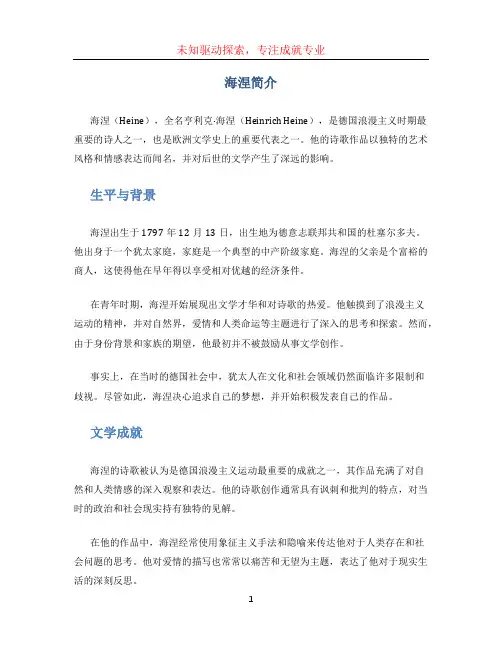
海涅简介海涅(Heine),全名亨利克·海涅(Heinrich Heine),是德国浪漫主义时期最重要的诗人之一,也是欧洲文学史上的重要代表之一。
他的诗歌作品以独特的艺术风格和情感表达而闻名,并对后世的文学产生了深远的影响。
生平与背景海涅出生于1797年12月13日,出生地为德意志联邦共和国的杜塞尔多夫。
他出身于一个犹太家庭,家庭是一个典型的中产阶级家庭。
海涅的父亲是个富裕的商人,这使得他在早年得以享受相对优越的经济条件。
在青年时期,海涅开始展现出文学才华和对诗歌的热爱。
他触摸到了浪漫主义运动的精神,并对自然界,爱情和人类命运等主题进行了深入的思考和探索。
然而,由于身份背景和家族的期望,他最初并不被鼓励从事文学创作。
事实上,在当时的德国社会中,犹太人在文化和社会领域仍然面临许多限制和歧视。
尽管如此,海涅决心追求自己的梦想,并开始积极发表自己的作品。
文学成就海涅的诗歌被认为是德国浪漫主义运动最重要的成就之一,其作品充满了对自然和人类情感的深入观察和表达。
他的诗歌创作通常具有讽刺和批判的特点,对当时的政治和社会现实持有独特的见解。
在他的作品中,海涅经常使用象征主义手法和隐喻来传达他对于人类存在和社会问题的思考。
他对爱情的描写也常常以痛苦和无望为主题,表达了他对于现实生活的深刻反思。
此外,海涅的作品还涉及到了宗教和政治问题。
他对犹太人身份和犹太教的探讨,以及对德国社会和民主制度的思考,使得他的作品更加丰富多样。
影响与遗产海涅的诗歌作品不仅在当时引起了广泛的关注和赞誉,而且对后世的文学产生了深远的影响。
他的作品在诗歌形式、艺术语言和思想内涵等方面都具有重要的创新意义。
海涅所表达的浪漫主义情感和对人类命运的思考,也对后来的诗人和作家产生了重要的影响。
他的作品被翻译成多种语言,传播到全球,并对世界各国的文学发展和思想启示产生了积极的作用。
海涅的思想和观点对于19世纪后期的德国知识分子和思想家来说仍然具有启发和借鉴意义。

浪漫主义时期(1798-1832)历史背景:Political and social factors:1. The American and French revolution: an upsurge of national liberation and democratic movementsAmerican revolution (1775-1783)—The formation of the independent United States.French revolution of 1789—“Liberty, equality and fraternity”2. The Industrial RevolutionEffect:1. One of the main effects of the rapid and vast economic changes was the urbanization of the growing population.2. The conditions of the working poor in the cities was intolerable.3. There were children working in dark, dangerous factories.4. The working classes and the poor lived in polluted, congested slums. Mass epidemics like typhoid fever afflicted the slums. The romantics, the liberals, the socialists, the anarchists and the communists all emerged with their ideologies at this point in history to criticize these man-made horrors.3. The Luddite movement (工人运动)思想文化背景:1.Rousseau 卢梭(page 2)—the father of romanticism—To rely on feelings, to follow the instincts and emotions.—Return to nature。

19世纪浪漫主义文学概述浪漫主义文学是19世纪欧洲文学的重要流派之一,它在文学史上具有重要的地位。
浪漫主义作品强调个人情感、内心体验和想象力的追求,呈现了一种反对工业化、科学性的态度。
本文将对19世纪浪漫主义文学进行概述,并探讨其主要特点、代表作家以及对后世影响等方面。
一、浪漫主义文学的起源与背景19世纪初期,欧洲正经历着一系列的政治、社会和经济变革。
工业革命的兴起导致了城市化和社会分工的加剧,人们对传统生活方式的认同感减弱。
同时,18世纪启蒙运动的理性主义思潮在社会中占据主导地位,强调理性和科学的发展。
这一时期也存在着政治上的动荡,比如法国大革命等。
在这种背景下,浪漫主义文学崛起了。
浪漫主义作家们通过文学表达了对现实世界的不满和对个人内心世界的追求,强调情感、幻想和自由。
他们试图逃离现实生活的束缚,用想象力和情感去探索更深层次的真实。
二、浪漫主义文学的主要特点1. 强调个人感受:浪漫主义文学重视个体的情感和体验,通过表达个人的内心世界来探索人类的本质。
作品中经常出现对自然、爱情、死亡等主题的情感表达。
2. 崇尚自然与幻想:浪漫主义作家对自然怀有浓厚的兴趣,并将自然视为灵感的源泉。
他们描绘了大自然的美与惊险,通过幻想和奇异的元素来创造出神秘和超越现实的文学形象。
3. 反对现实世界:浪漫主义文学对现实世界的社会、政治和经济现象持批判态度。
作家们通过理想化的情节、角色和场景来展示对社会现实的不满,并寻求超越现实的解决途径。
4. 爱情的理想化:浪漫主义文学中经常出现一种理想化的、超越世俗的爱情观。
爱情被看作是灵魂的追求,是心灵的交流和融合,同时也是一种超越日常生活的力量。
5. 强调想象力和创造力:浪漫主义作家通过丰富的想象力和创造力来创作作品,创造出奇妙、富于想象力的情节和形象。
在他们的笔墨下,世界变得更加多样、丰富。
三、浪漫主义文学的代表作家及作品1. 威廉·华兹华斯《世事如梦》:这是一部描写自然风景和人类情感的抒情诗集,诗人通过细腻的描绘和充满强烈情感的语言,创作出美轮美奂的浪漫主义佳作。

五.浪漫主义时期(1798年-1832年)托马斯·格雷(Thomas Gray):“感伤主义”(Sentimentalism)诗人。
“墓园派诗人”(graveyard school)。
代表作《墓园挽诗》(An Elegy Written in a Country Churchyard)。
威廉·布莱克(William Blake):诗人,代表作《天真之歌》(Songs of Innocence),《经验之歌》(Songs of Experience)。
罗伯特·彭斯(Robert Burns):苏格兰杰出的农民诗人。
作品:《一朵红红的玫瑰》(A Red, Red Rose),《昔日的好时光》(Auld Lang Syne)。
威廉·华兹华斯(William Wordsworth):“湖畔派”诗人(Lake poets),“桂冠诗人”(Poet Laureate)。
代表作《独自云游》(I Wandered Lonely as a Cloud),《孤寂的割麦女》(The Solitary Reaper),《丁登寺杂咏》(Lines Composed a Few Miles about Tintern Abbey),《序曲》(The Prelude)。
塞缪尔·泰勒·柯勒律治(Samuel Taylor Coleridge):“湖畔派”诗人(Lake poets)。
代表作《古舟子咏》(The Rime of the Ancient Marine),《忽必烈汗》(Kubla Khan),《克里斯塔贝尔》(Christabel)。
罗伯特·骚塞(Robert Southey):最年轻的“湖畔派”诗人(Lake poets),“桂冠诗人”(Poet Laureate)。
代表作短诗《布莱尼姆之战》(The Battle of Blenheim),《我与死者做伴的日子已经结束》(My Days among the Dead are Past),《撒拉巴》(Thalaba the Destroyer),长诗《克哈马的诅咒》(The Curse of Kehama)。
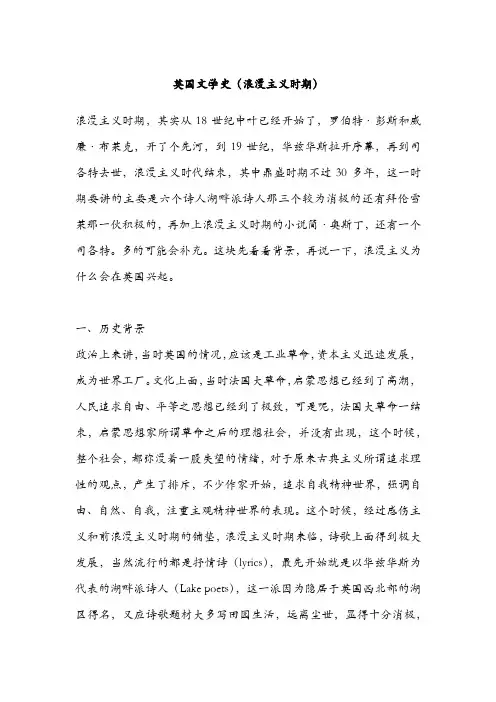
英国文学史(浪漫主义时期)浪漫主义时期,其实从18世纪中叶已经开始了,罗伯特·彭斯和威廉·布莱克,开了个先河,到19世纪,华兹华斯拉开序幕,再到司各特去世,浪漫主义时代结束,其中鼎盛时期不过30多年,这一时期要讲的主要是六个诗人湖畔派诗人那三个较为消极的还有拜伦雪莱那一伙积极的,再加上浪漫主义时期的小说简·奥斯丁,还有一个司各特。
多的可能会补充。
这块先看看背景,再说一下,浪漫主义为什么会在英国兴起。
一、历史背景政治上来讲,当时英国的情况,应该是工业革命,资本主义迅速发展,成为世界工厂。
文化上面,当时法国大革命,启蒙思想已经到了高潮,人民追求自由、平等之思想已经到了极致,可是呢,法国大革命一结束,启蒙思想家所谓革命之后的理想社会,并没有出现,这个时候,整个社会,都弥漫着一股失望的情绪,对于原来古典主义所谓追求理性的观点,产生了排斥,不少作家开始,追求自我精神世界,强调自由、自然、自我,注重主观精神世界的表现。
这个时候,经过感伤主义和前浪漫主义时期的铺垫,浪漫主义时期来临,诗歌上面得到极大发展,当然流行的都是抒情诗(lyrics),最先开始就是以华兹华斯为代表的湖畔派诗人(Lake poets),这一派因为隐居于英国西北部的湖区得名,又应诗歌题材大多写田园生活,远离尘世,显得十分消极,华兹华斯和柯勒律治合编的《抒情歌谣集》(The lyrical ballads)下面先来讲一下,华兹华斯。
二、代表人物诗歌:1、挚爱自然的华兹华斯(William Wordsworth)华兹华斯出生于一个律师家庭,读书的时候,除了学习拉丁语和古典文学就是流连于山水之间,培养对自然的爱好,后来他去了剑桥大学读书,期间,研究斯宾塞,乔叟等人的文学,随后,徒步旅行到法国,被法国革命提出的“自由”、“平等”的口号所吸引,在那里住了一年多,随后“九月大屠杀”和雅各宾派的恐怖统治,大大地浇灭了他对于革命地热情,在朋友的帮助下,在湖区的乡舍中住了两年,这个时期基本热心于创作,期间还认识了柯勒律治,两个人经常相互切磋诗艺,1798年,就联手出版了《抒情歌谣集》,开一代诗风,诗集没出版的时候,华兹华斯就在致力于写作他自己的《序曲》(The Prelude ),后面就是在他离世之前,分别迁过两次,都在湖区住了七八年。
简述19世纪欧洲浪漫主义文学的特点及代表人物(1)19世纪欧洲浪漫主义文学的代表人物浪漫主义文学产生于18世纪末,19世纪上半叶为繁荣时期。
浪漫主义的理论策源地在德国,但在文学上成就最高的是英、法两国。
欧洲的浪漫主义在发展历程中出现过三次高潮:①第一次是在1805年左右,这一时期是英国的湖畔派诗人创作的高峰期,法国的夏多布里昂和史达尔夫人开始引介德国的浪漫主义理论。
②第二次高潮从英国诗人拜伦开始,雪莱和济慈紧随其后。
这一时期的法国有拉马丁和维尼等才华横溢的诗人。
此外,意大利的白尔谢、曼佐尼以及德国的霍夫曼等人也是这一时期重要的浪漫派作家。
③浪漫主义文学的第三个高潮发生在法国,约从1827年至1848年,以浪漫主义文学的集大成者雨果为代表。
这一时期,浪漫主义思潮也波及俄国、东欧和美国,在美国产生了梅尔维尔、惠特曼等浪漫主义大师。
(2)19世纪欧洲浪漫主义文学的特点①思想特点a.强调创作的绝对自由,反对古典主义的清规戒律,要求突破文学描绘现实的范围。
浪漫主义在发展过程中,与古典主义进行了激烈的斗争,古典主义主张只能描绘贵族和上层人物,排斥民间文学,戏剧创作规定要遵循“三一律”,推崇典雅和崇高的风格等等,已成为束缚文学发展的桎梏。
浪漫主义终于冲破了这道顽固的藩篱,在创作自由的口号下开辟了文学的新天地。
个性解放是他们高举的旗帜,以反对社会对人的精神束缚和压迫,这是他们宣扬的时代新精神。
b.从民主主义的立场,或者从留恋旧制度的立场,抨击封建制度或者资本主义的罪*恶现象。
浪漫派可分为带有资产阶级倾向和贵族倾向的两类作家。
前者具有高昂的革命热情,揭露现实的黑暗和不合理现象,对未来社会充满美好的理想。
后者以怀旧的态度去抨击资本主义。
但是,这两类作家批判现实的思想武器都是人道主义,他们一般都同情下层人民的苦难生活,并以此去构筑理想的社会图景。
c.酷爱描写中世纪和以往的历史,从司各特开始,至雨果、大仲马等浪漫派小说家,大都以历史题材为描写对象。
浪漫主义时期的划分
“漫”论的起源是德国,但文学成就最高的两个国家是英国和法国。
欧洲的浪漫主义在发展历程中出现过三次 *** 。
第一次是在1805年左右,这是英国诗人莱克诗人的创作高峰。
法国的夏多布里昂和斯达尔夫人开始引进德国浪漫主义理论。
第二次 *** 则从英国诗人拜伦开始,他的作品在1815年至1825年间风靡欧洲,雪莱和济慈紧随其后。
在这一时期,法国文坛相对平静,但也有杰出的诗人,如拉马丹和姚一奇。
此外,意大利的贝尔舍、曼佐尼和德国的霍夫曼也是这一时期重要的浪漫主义作家。
浪漫主义文学的第三个 *** 发生在法国,约从1827年至1848年,以浪漫主义文学的集大成者维克多·雨果为代表。
这一时期,浪漫主义也传到了俄罗斯、东欧和美国,出现了梅尔维尔、惠特曼等浪漫主义大师。
1848年后,浪漫主义文学运动基本结束,但浪漫主义思潮并未消失,一直持续发展至今。
消极浪漫主义者无法正视社会现实的尖锐矛盾,采取消极逃避的态度。
他们的思想与被推翻的封建贵族的意识形态联系在一起。
他们从反对资产阶级革命运动出发,反对现状,留恋过去,美化中世纪的宗法制度,梦想从古老的封建社会中寻求精神慰藉和寄托。
浪漫主义的出现,其实是没落封建贵族思想情感的文学反映。
作者是德国的莱格尔兄弟,即德国的O. S .莱格尔和F. S .莱格尔,法国的诺瓦利斯、夏多布里昂,俄国的拉马丁·姚一奇、茹科夫斯基,英国的华兹华斯、柯勒律治、骚塞等等。
浪漫主义诗人是谁大家知道浪漫主义诗人是谁吗?不知道,别着急,下面让店铺告诉你吧!浪漫主义诗人是谁屈平(约公元前339年?~约公元前278年?)字原,通常称为屈原,又自云名正则,字灵均,汉族,战国末期楚国丹阳(今湖北秭归)人,楚武王熊通之子屈瑕的后代.屈原虽忠事楚怀王,但却屡遭排挤,怀王死后又因顷襄王听信谗言而被流放,最终投汨罗江而死.屈原是中国最伟大的浪漫主义诗人之一,也是我国已知最早的著名诗人,世界文化名人.他创立了“楚辞”这种文体,也开创了“香草美人”的传统.代表作品有《离骚》《九歌》等.再往后走,就是唐代的李白了,李白(701年2月28日—762),字太白,号青莲居士.中国唐朝诗人,有“诗仙”之称,是伟大的浪漫主义诗人.汉族,祖籍陇西郡成纪县(今甘肃省平凉市静宁县南),出生于蜀郡绵州昌隆县(今四川省江油市青莲乡),一说出生于西域碎叶(今吉尔吉斯斯坦托克马克).逝世于安徽当涂县.存世诗文千余篇,代表作有《蜀道难》、《行路难》、《梦游天姥吟留别》、《将进酒》、《梁甫吟》、《静夜思》等诗篇,有《李太白集》传世.和李白同位唐代浪漫主义诗人的还有李贺,李贺(790~816),唐代著名诗人,汉族,河南福昌人.字长吉,世称李长吉、鬼才、诗鬼等,与李白、李商隐三人并称唐代“三李”.祖籍陇西,生于福昌县昌谷(今河南洛阳宜阳县).一生愁苦多病,仅做过3年从九品微官奉礼郎,因病27岁卒.李贺是中唐浪漫主义诗人的代表,又是中唐到晚唐诗风转变期的重要人物.代表作品:《李凭箜篌引》、《雁门太守行》、《金铜仙人辞汉歌.之后差不多就是近代了.有两位比较出名的,一是郭沫若,一是徐志摩. 扩展:基本资料:姓名:乔治戈登拜伦(George Gordon Byron)性别:男出生年月:1788年1月22日出生地:英国伦敦称谓:英国浪漫主义文学的杰出代表生平履历1788年1月22日拜伦出生于伦敦,父母皆出自没落贵族家庭。
他天生跛一足,并对此很敏感。
19世纪浪漫主义诗歌作品浪漫主义是一种充满激情、爱情、自由和个人情感的艺术运动,它在19世纪的欧洲迅速兴起,并对当时的诗歌创作产生了深远的影响。
19世纪的浪漫主义诗歌作品充满了对自然、对爱情、对人类内心世界的渴望和表达。
这篇文章将介绍几位浪漫主义诗人以及他们的代表作品,带领读者进入那个富有情感与想象的时代。
1. 维克多·雨果(Victor Hugo,1802-1885)维克多·雨果是19世纪法国最重要的文学家之一,也是浪漫主义诗人的代表人物之一。
他笔下的诗歌充满了激情和力量,其中最著名的作品之一是《悔过》。
这首诗通过表现一个罪犯的内心和他对过去所犯罪行的反思,展现了对救赎和宽恕的渴望。
2. 约翰·济慈(John Keats,1795-1821)约翰·济慈是英国浪漫主义诗人中最具代表性的人物之一。
他的诗歌充满了对大自然的赞美和个人内心世界的探索。
《秋颂》是他最著名的作品之一,通过描绘秋天的美丽景色,表达了诗人对短暂性和美的追求。
3. 罗伯特·伯恩斯(Robert Burns,1759-1796)罗伯特·伯恩斯是苏格兰浪漫主义诗人的代表人物,他的诗歌以苏格兰方言和民歌的形式呈现,充满了对苏格兰乡村生活和自然环境的热爱。
其中最著名的作品之一是《继续欢乐,亨特!》,它描述了一个农民和他的朋友一同享受乡村生活的场景,并表达了对友谊和欢乐的向往。
4. 费德里克·舒勒(Friedrich Schiller,1759-1805)费德里克·舒勒是德国浪漫主义诗人和剧作家,他的作品融合了浪漫主义的情感和对人性的关怀。
《钟声》是他最著名的诗歌之一,通过描绘钟声在夜晚中回荡的场景,表达了对自由和幸福的追求。
5. 虞世南(665-762)虞世南是唐代中国著名的浪漫主义诗人,他的诗歌以叙述爱情故事和表达个人情感为主。
《浪淘沙·九曲黄河万里沙》是他最著名的作品之一,通过描绘河水奔腾、万里沙漫的景象,表达了对爱情的热切追求和无尽的思念之情。
浪漫主义时期
浪漫主义时期开始于十八世纪末,到内战爆发为止,是美国文学史上最重要的时期。
华盛顿·欧文出版的《见闻札记》标志着美国浪漫主义文学的开端,惠特曼的《草叶集》是浪漫主义时期文学的压卷之作。
浪漫主义时期的文学是美国文学的繁荣时期,所以也称为“美国的文艺复兴”。
美国社会的发展哺育了一个伟大民族的文学,年轻的美国没有历史的沉重包袱,很快在政治、经济和文化方面成长为一个独立的国家。
这一时期也是美国历史上西部扩张时期,到1860年领土已开拓到太平洋西岸。
到十九世纪中叶,美国已由原来的十三个州扩大到二十一个州,人口从1790年的四百万增至1860年的三千万。
在经济上,年轻的美国经历向工业的转化,影响所及不仅仅是城市,而且也包括农村。
蒸汽动力在工、农业生产上的运用、工厂的建立、劳动力的大量需求以及科技上的发明创造使经济生活得到了重组。
另外,大量移民促进了工业更加蓬勃的发展。
政治上,民主与平等成为这个年轻国家的理想,产生了两党制。
值得一提的是这个国家的文学和文化生活。
随着独立的美国政府的成立,美国人民已感到需要有美国文学,表达美国人民所特有的经历:早期清教徒的殖民,与印第安人的遭遇,边疆开发者的生活以及西部荒原等。
这个年轻国家的文学富有想象,已产生了一种文学环境。
报刊杂志如雨后春笋,出现了一大批文学读者,形成了十九世纪上半叶蓬勃的浪漫主义的文学思潮。
浪漫主义时期(1798-1832)历史背景:Political and social factors:1. The American and French revolution: an upsurge of national liberation and democratic movementsAmerican revolution (1775-1783)—The formation of the independent United States.French revolution of 1789—“Liberty, equality and fraternity”2. The Industrial RevolutionEffect:1. One of the main effects of the rapid and vast economic changes was the urbanization of the growing population.2. The conditions of the working poor in the cities was intolerable.3. There were children working in dark, dangerous factories.4. The working classes and the poor lived in polluted, congested slums. Mass epidemics like typhoid fever afflicted the slums. The romantics, the liberals, the socialists, the anarchists and the communists all emerged with their ideologies at this point in history to criticize these man-made horrors.3. The Luddite movement (工人运动)思想文化背景:1.Rousseau 卢梭(page 2)—the father of romanticism2.—To rely on feelings, to follow the instincts and emotions.3.—Return to nature。
4.Edmund Burke 埃德蒙伯克( Page 2)5.—Reflection on the Revolution in France (1790)《法国革命感想》6.Thomas Paine 托马斯潘恩(page 3)7.—Rights of Man (1791)浪漫主义简介:+It was an artistic, literary, and intellectual movement that originated in Europe toward the end of the 18th century and in most areas was at its peak in the approximate period from 1800 to 1850.+Partly a reaction to the Industrial Revolution,it was also a revolt against aristocratic social and political norms of the Age of Enlightenment and a reaction against the scientific rationalization of nature.+ It was embodied most strongly in the visual arts, music, and literature, but had a major impact on historiography, education and the natural sciences.+ Its effect on politics was considerable and complex; while for much of the peak Romantic period it was associated with liberalism and radicalism, in the long term its effect on the growth of nationalism was probably more significant.+The term was used in Germany and France at the end of 18th and beginning of 19thC to classify a new movement in literature, especially in poetry.浪漫主义时期代表人物共同特征:(1) They cultivated imaginative freedom, though in very various ways, and this encouraged them to use a variety of sometimes very loose poetic forms.(2) Each of them tended to express the feelings of man in solitude as opposed to those of man in society.(3) They shared a tendency to be "inward turning" rather than outward-looking.(4) All, except perhaps Blake, responded vividly to nature and the natural and uncivilized way of life..(5) They tended to use language with more freedom and information than the 18th C poets, and emphasize the need for spontaneity in thought and action and in the expression of thought.(6) They were all, but in different ways, profoundly affected by the great historical fact of the French Revolution, and by its various immediate consequences, especially the career of Napoleon; Blake, Wordsworth, Coleridge began as warm revolutionary sympathizers, but the Napoleonic wars caused Blake to withdraw and turned the other two into convinced conservatives.(7) All of them exalted the individual genius.General characteristic features of the romantic movement()1. Subjectivism2. Spontaneity3. Singularity4. Simplicity: everyday language spoken by the rustic people5. A dominating note of melancholy6. A freer verse form浪漫主义诗人派别:ke poet—the passive or escapist romanticists: Wordsworth, Coleridge, Southey—detesting the real world, escaping from the reality.2.Active or radical romanticists: Byron, Shelley, Keats3.—striving to strengthen man’s will to live and raise him up against the darkness in theworld.4.Principles of poetry1 Subjects:1). The great subjects of poetry are “essential passions of the heart” and “the great and simple affections.”(Preface to Lyrical Ballads(2nd ed.)).2). Incidents and situations from common life2. Source of poetry: feelings1). “all good poetry is the spontaneous overflow of powerful feelings”2). Emotion recollected in tranquility3. Language: “real language of men in a state of vivid sensation” (no poetic diction)诗人简介:1.William Wordsworth:早期经历:+Both parents had died by the time Wordsworth was 13+John Wordsworth, his father, was very educated and liberal and encouraged his children to be the same+Wordsworth’s hometown was in the beautiful Lake District prompting his early love and appreciation of nature, along with imagination自然和妹妹的影响:+Believed all individuals have potential to reach a transcendental understanding of nature through his or her relationship with nature+Believed nature was the glue that binds everything together+Dorothy, Wordsworth’s sister, was very important to him–She experienced nature at an early age and her thoughts and impressions influenced Wordsworth.2.Samuel Taylor Coleridge:English poet, literary critic and philosopher; a founder of the Romantic Movement in England (with his friend William Wordsworth); a member of the Lake Poets.He coined many familiar words and phrases, including the celebrated suspension of disbelief. He was a major influence on Emerson, and American transcendentalism.3.George Gordon ByronPersonal Image:a leader of the era's poetic revolution, he named Alexander Pope as his master;a worshiper of the ideal, he never lost touch with reality;a deist and freethinker, he retained from his youth a Calvinist sense of original sin;a peer of the realm, he championed liberty in his works and deeds, giving money,time, energy, and finally his life to the Greek war of independenceWriting forms:satire, verse narrative, ode, lyric, speculative drama, historical tragedy, confessional poetry, dramatic monologue, seriocomic epic, and voluminous correspondence, written in Spenserian stanzas, heroic couplets, blank verse, terza rima, ottava rima, and vigorous proseterza rima三行诗节押韵法(象旦丁《神曲》中所用的诗体,三行为一节,每节的第二行与下一节的第一、三行押韵)ottava rima(意)八行体(一种诗体,每行十或十一个音节,前六行交替押韵,后两行另成一组同脚韵)拜伦式英雄:Definition:Byron’s chief contribution to English poetry. Such a hero i s a proud, rebellious figure ofnoble origin. Passionate and powerful, he is to right all the wrongs in a corrupt society, and he would fight single-handedly against all the misdoings. Thus this figure is a rebellious individual against outworn social systems and conventions.The Byronic hero first appears in Byron's semi-autobiographical epic narrative poem Childe Harold's Pilgrimage (1812–1818).Characteristics:The Byronic hero typically exhibits several of the following traits:ArrogantCunning and able to adaptCynicalDisrespectful of rank and privilegeEmotionally conflicted, bipolar, or moodyHaving a distaste for social institutions and normsHaving a troubled past or suffering from an unnamed crimeIntelligent and perceptive4.Percy Bysshe ShelleyShelley is one of the leading Romantic poets, an intense and original lyrical poet in the English language. He has a reputation as a difficult poet: erudite (learned), complex (difficult), full of classical and mythological allusions. His style abounds in personification and metaphor and other figures of speech.Shelley loved the people and hated their oppressors and exploiters.He called on the people to overthrow the rule of tyranny and injustice and prophesied a happy and free life for mankind.He stood for this social and political ideal all his life.He and Byron are regarded as the two great poets of the younger generation in English Romanticism.5.John KeatsMajor features of Keats’ poetry1.Characterized by exact and closely-knit construction, emotional descriptions, and byforce of imagination, gives transcendental values to the physical beauty of the world.2.Always sensuous, colorful and rich in imagery.3.Major subjects: love & beauty, suffering & death.His artistic aim is to create a beautiful world of imagination as opposed to the miserable reality of his day. His leading principle is “Beauty is truth, truth is beauty.”6.Charles LambLiterature career:Lamb lived under the poetic shadow of his friend Coleridge. In the final years of the18th century Lamb began to work on prose with the novella entitled Rosamund Gray,a story of a young girl who was thought to be inspired by Ann Simmonds, with whomCharles Lamb was thought to be in love. Although the story is not particularly successful as a narrative because of Lamb's poor sense of plot, it was well thought of by Lamb's contemporaries and led Shelley to observe “what a lovely thing is Rosamund Gray! How much knowledge of the sweetest part of our nature in it!”In the first years of the 19th century Lamb began his fruitful literary cooperation with his sister Mary. Together they wrote at least three books for William Godwin’s Juvenile Library. The most successful of these was of course Tales From Shakespeare.Works:Lamb also contributed a footnote to Shakespearean studies at this time with his essay "On the Tragedies of Shakespeare," in which he argues that Shakespeare should be read rather than performed in order to gain the proper effect of his dramatic genius.Lamb also contributed to the popularization of Shakespeare's contemporaries with his book Specimens of the English Dramatic Poets Who Lived About the Time of Shakespeare.Although he did not write his first Elia essay until 1820, Lamb’s gradual perfection of the essay form for which he eventually became famous began as early 1802 in a series of open letters to Leigh Hunt’s Reflector. The most famous of these is called "The Londoner" in which Lamb famously derides the contemporary fascination with nature and the countryside.7.Walter ScottA Scottish historical novelist, playwright, and poetPopular throughout much of the world during his timeThe first English-language author to have a truly international career in his lifetime。